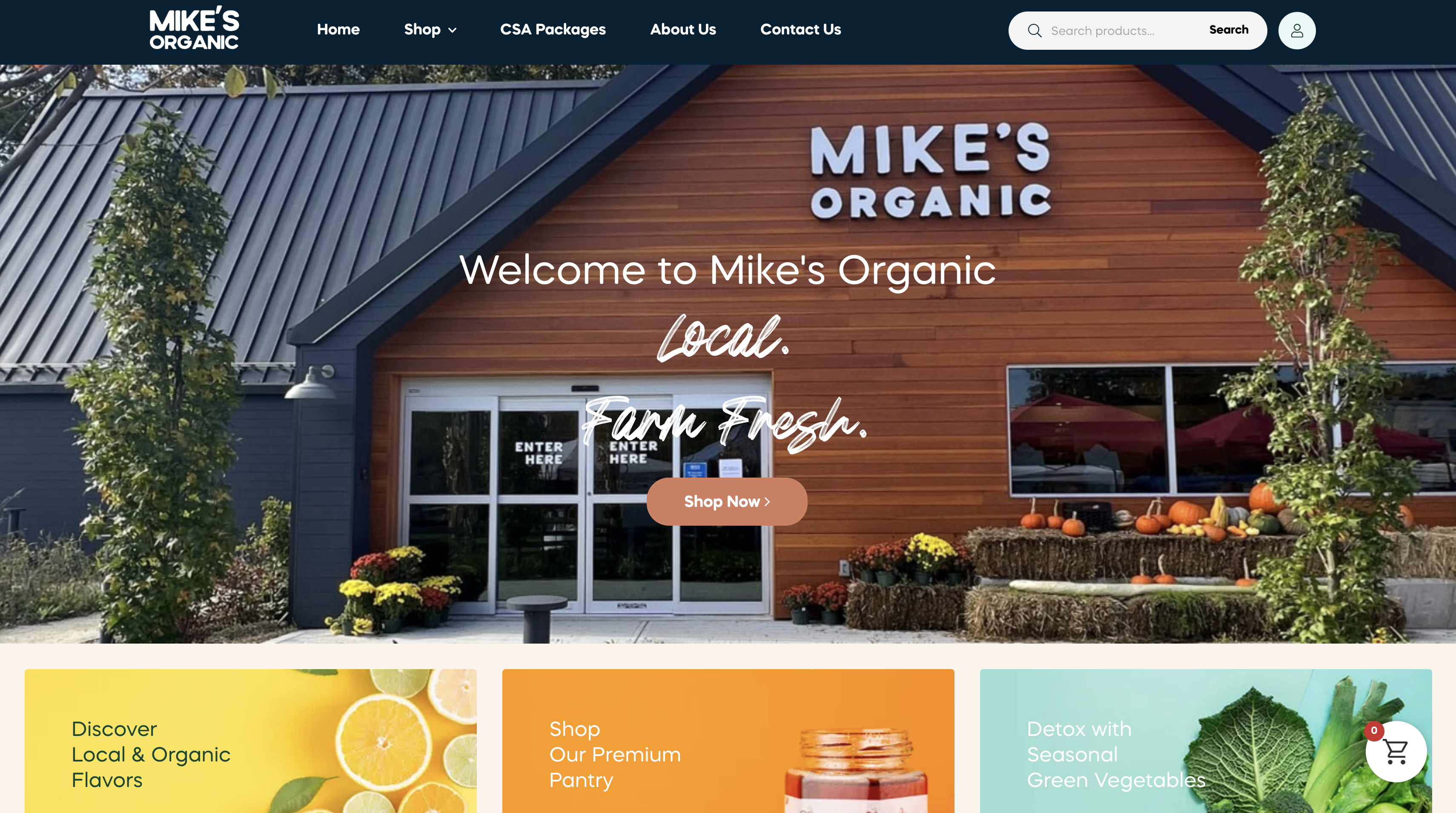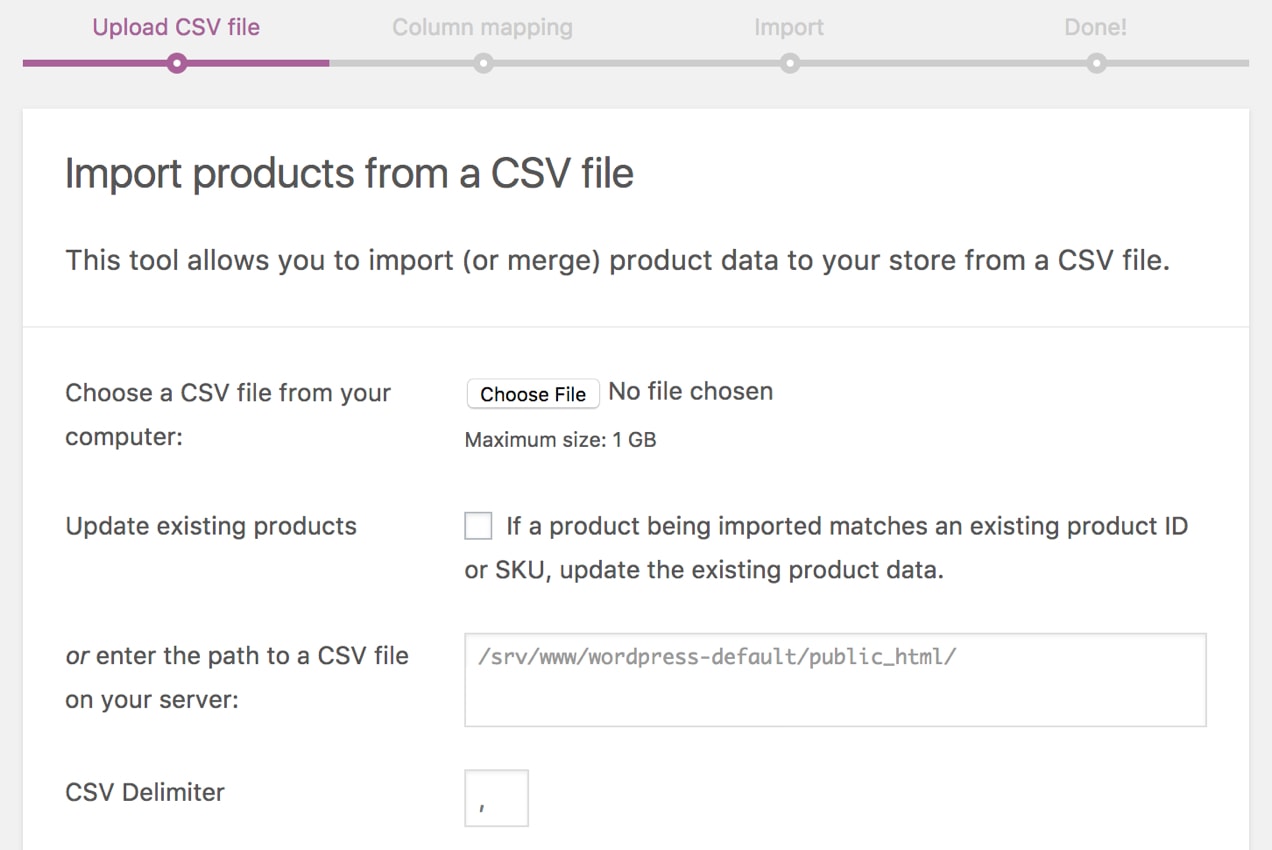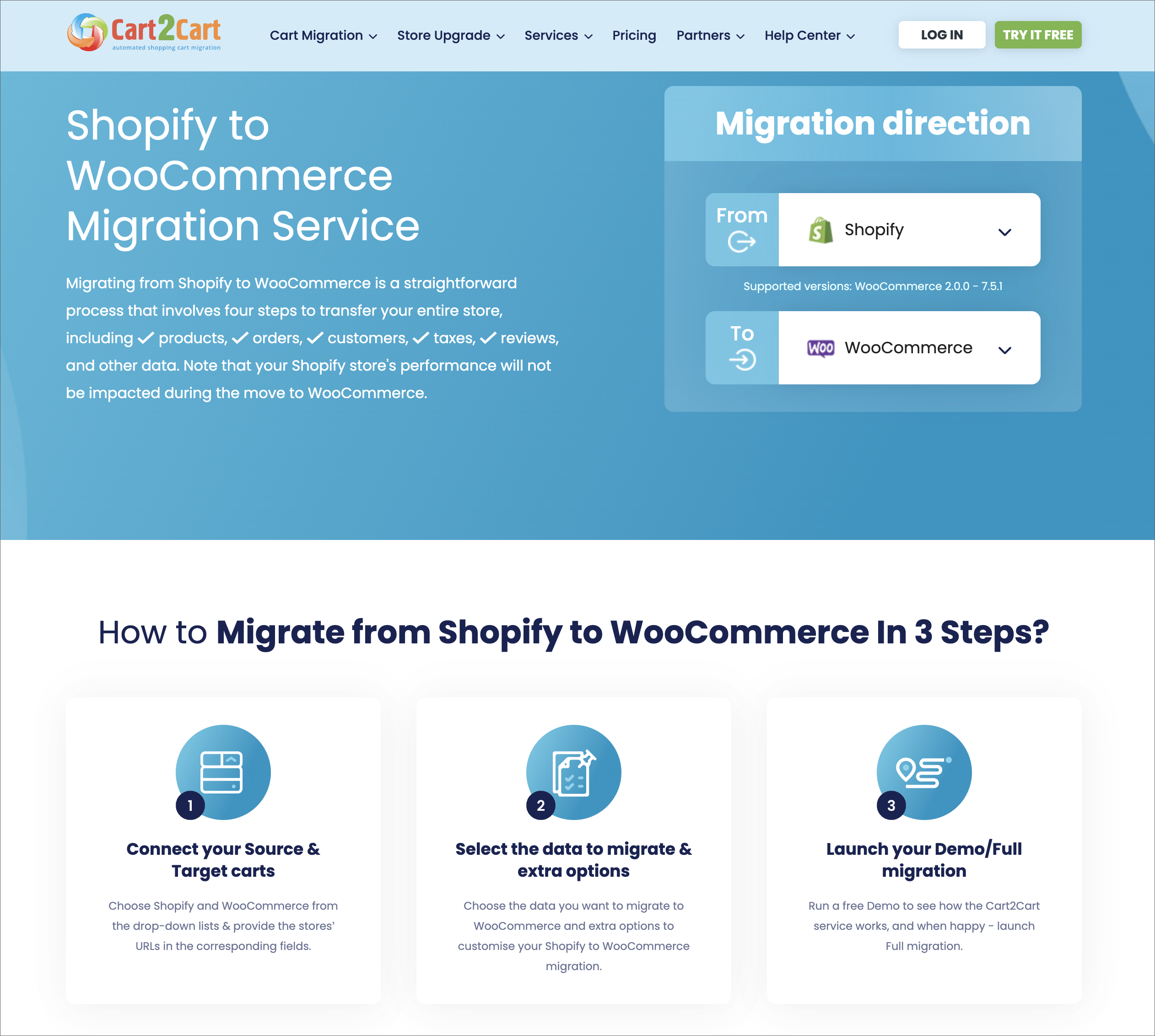Are you considering moving your store from Shopify to WooCommerce?
Changing eCommerce platforms may seem like a big hurdle to overcome, but it’s easier than you might think to move your products, customers, and orders to WooCommerce. That being said, we’re here to support you, should you need any help. With Woo, high-volume stores qualify for unique benefits like dedicated support and discounted extensions. Learn more about how our team can help your business grow.
In fact, there’s a solution that’s virtually hands-off and ensures a worry-free migration process. There’s no need for any technical knowledge; just connect the two platforms and you’re ready to go!
Below, you’ll learn why WooCommerce is a great choice for your online store and how to seamlessly move from Shopify to WooCommerce.
Why choose WooCommerce instead of Shopify
Here are a few reasons you might want to switch from Shopify to WooCommerce:
More control over your store
WooCommerce allows you to have full control over your website. It’s open-source, which gives you the power to customize it as much as you’d like. You can create exactly the store you want without limitations.
With WooCommerce, you have full control over:
Search engine optimization. While your search engine rankings are largely based on the work you put into your site and content, WooCommerce allows you to edit every single aspect of your SEO, no matter how technical.
You’ll also benefit from its seamless integration with WordPress, which enables you to easily publish consistent, high-quality content. For example, wellness company Equilibria does an excellent job integrating blog content into their online store. Their posts provide additional education on health topics, product ingredients, and wellness habits, letting customers know that the brand is invested in their wellness on all fronts.
Payment gateway integration. Both Shopify and WooCommerce offer integration with major payment solutions, but WooCommerce allows you to connect to lesser-known, niche payment gateways that might be necessary for an international store. View available payment gateways with WooCommerce.
Or, choose WooPayments, a seamless solution that simplifies the entire process for you. Manage payments, disputes, deposits, and recurring revenue from the same place you handle the rest of your site. Reduce cart abandonment by accepting payments directly on your site, along with Apple Pay for one-click checkout. Plus, you can even take advantage of instant deposits, so your money ends up in your bank account within minutes (unlike Shopify’s two-day minimum). When it comes to money, you want something that’s simple and easy to understand — WooCommerce has you covered.
And, unlike WooCommerce, Shopify charges additional transaction fees for all third-party gateways. After you’ve worked hard to create fantastic products and market them to new customers, the last thing you want is to narrow your profit margins. Even for small stores, additional transaction fees can amount to thousands of dollars in lost revenue.
Backups. While Shopify allows you to export customer data and orders, you have to pay a fee to back up your website design and settings. WooCommerce, however, has a variety of excellent, free backup options. And if you need more advanced functionality, Jetpack Backup is an excellent choice. It stores your files separately from your website for extra protection, and can even save all of your order information and changes in real time.
As your online store grows, it’s important to maintain as much control as possible so that you can make the best decision for your specific situation. For example, when scaling your store, you may need to upgrade to a host that can handle more traffic or provide advanced security options. With WooCommerce, you can choose any hosting provider that you like.
Endless flexibility and customization
One of the biggest benefits of WooCommerce is its flexibility. Both WordPress and WooCommerce are open-source, which means that anyone can copy, modify, or change the source code however they’d like. In contrast, Shopify is closed source; they retain full ownership over their core code.
An open-source content management system, like WordPress, also means that there are endless customization options because developers can create plugins or themes to serve any number of specific functions. The WordPress plugin repository has more than 54,000 free options that help with everything from design to functionality and marketing. And WooCommerce offers an extension marketplace with over 300 add-ons built specifically for online stores.
If your products are complicated or unique, you can set up your store however you’d like with WooCommerce. Here are a few ways to do that:
- Accept deposits from your customers or offer payment plans.
- Allow shoppers to mix and match products.
- Sell your photographs online in a visually-pleasing way.
- Add, edit, and remove fields on the Checkout page.
- Offer product add-ons, like upgrades, gift wrapping, and customization.
Of course, you can also sell everything from products and services to downloads, subscriptions, memberships, and bookings.

Here are just a few examples of businesses using WooCommerce:
- Phi Phi Pirate Boat – a party boat touring company that offers bookings for themed trips around the Thai islands of Phi Phi.
- Mike’s Organic – a sustainable, healthy food subscription service with weekly delivery to customers.
- PHLearn – a membership program with access to a library of design templates and tutorials
- TipoType – a font foundry selling licenses to digital files.
- It Gets Better Project – a nonprofit that sells physical products and accepts online donations.
When it comes to designing your eCommerce site, the integration between WordPress and WooCommerce provides a big benefit. Thanks to the free WordPress block editor, you can create virtually any design you want for landing pages, blog posts, categories, and more. Add elements like text, images, videos, galleries, and columns (to name just a few) in a couple of clicks without needing to know any code or hire a developer.
There are also endless website themes that range from customizable designs to drag-and-drop layouts for niche stores. Block Shop, for example, was designed specifically for WooCommerce, and helps you align your online store with your brand’s style.
Your site design can be as simple or as complex as you’d like it to be. Here are a few examples of stores using WooCommerce to create beautiful designs:
- AeroPress incorporates custom animations and graphics into their homepage.
- Good Dye Young has a blog experience that’s as unique as their brand.
- Flwr uses beautiful typography to make a statement.
- ShadowTrader has clean, effective landing pages for each of their trading options.
- Green Dinner Table provides a branded, easy-to-use FAQ page for their customers.
- Magna-Tiles showcases product images in a fun, unique way.
More control over pricing
Both WordPress and WooCommerce are free, so you’ll just be responsible for your domain name, hosting, and any extensions that you’d like to use. You can choose any provider and mix and match extensions based on your needs. This flexibility prevents you from paying for functionality that you don’t use.
Read our WooCommerce Pricing post for a clear idea of how much it costs to run a WooCommerce store.
If you use Shopify, you’re charged for the following:
- Monthly plans. Depending on which Shopify plan you have, you could be paying between $29.99 and $299 a month. The more features you want, the more you have to pay. For example, if you’d like to offer live shipping rates, you need to use the Advanced Shopify plan.
- Add-ons. Many Shopify add-ons that provide additional functionality require monthly fees. For example, if you want to offer waitlists for your products, you would need to pay an additional $14.99 a month ($179.88 a year). This can quickly add up! Many WooCommerce extensions are free, and paid extensions often charge a yearly fee that can save you money. For example, waitlist functionality would cost just $49.00 a year.
- Transactions. If you use an external payment gateway, Shopify takes between 0.5% and 2% per transaction, in addition to any fees your payment gateway charges. It doesn’t take long for these fees to add up! Even if your store only processes a few transactions a day, you could lose thousands of dollars in profit each year. With WooCommerce, however, you’re not charged any additional transaction fees. This means you keep more money in your pocket.
Shipping costs and tools
Shopify does allow merchants to charge shipping fees and print labels from their account. It also includes discounted pricing from USPS, UPS, and DHL. However, in order to show live rates from carriers, you must have an Advanced plan, which comes at the hefty price of $299 per month.
WooCommerce offers an extension — WooCommerce Shipping — that also allows for easy label printing from your dashboard and negotiated discounts with USPS and DHL. In addition, WooCommerce allows you to display real-time shipping rates from carriers for only $79 a year.
One of the biggest differences to note, however, is that WooCommerce is all about supporting their community of entrepreneurs and small business owners. Though their core platform is completely free, they still offer additional resources and tools like WooCommerce Shipping at no cost.
When you’re starting or scaling your eCommerce business, it’s important that you keep as much money in your pocket as possible. WooCommerce helps you invest your money in the areas that will grow your business and make it the most successful.
Unlimited variations
Product variations are the options offered to customers for each product. For example, if you sell t-shirts, you might offer red, blue, green, and yellow in sizes XS – 3XL. The combination of colors and sizes would create 28 variations.
Depending on your products, variations can quickly add up. After all, you want your customers to be able to choose the right product for their needs!
Shopify limits variations on each product to 100. If you sell men’s shoes that are available in three widths (narrow, regular, and wide), standard sizes 6-15 (including half sizes), and three colors, you’d have 153 variations. This would exceed Shopify’s limits. However, with WooCommerce, you can offer as many product variations as you need.
Access to a close-knit community
Using WooCommerce means that you’ve joined a community of people who want to learn and grow with you. Every year, hundreds of thousands of developers and site owners meet up virtually and in over 400 cities around the world. Find out about WooCommerce meetups in your area.

For each WordPress update, hundreds of volunteers contribute their time, simply because they’re passionate about creating great software that powers the web. There are frequent Contributor Days, both online and in-person, where developers and users work together to constantly improve the platform.
This community is also behind the excellent support forums for both WordPress and WooCommerce. There, you can submit a question and get responses from a variety of perspectives. It doesn’t matter how basic or complicated your situation is; someone’s there to help you out!
WordPress is all about community over competition — they all want one another to succeed. So welcome to the WordPress family. You’ll love it here!
How to migrate to WooCommerce from Shopify
If you already have a store on Shopify and want to move to WooCommerce, you might feel overwhelmed. After all, you don’t want to lose existing customer data and orders, and you want the process to be as easy and seamless as possible.
First, you need to choose a hosting plan, install WordPress, and set up WooCommerce. Learn how to do this in our five-step getting started guide.
It’s important to note that none of these methods recreate your website design and content. However, many free and premium themes are available to help you build anything that you want! The Storefront theme, for example, is both intuitive and flexible, and offers a variety of child themes for specific niches.
If you don’t want to design your website on your own, hire one of our experts.
There are a few ways that you can migrate store data from Shopify to WooCommerce safely and securely.
1. Manual import/export
Although it may seem a little time-consuming, manually migrating your products is free and relatively straightforward.

- Export and download your product data from Shopify.
- In your WordPress dashboard, navigate to WooCommerce → Products.
- Select Import at the top. There, you’ll find a built-in product CSV importer that will make the process easier.
- Click Choose File and select the CSV file that you want to import. Click Continue.
- You’ll see the Column Mapping screen, where WooCommerce automatically attempts to match the column name of your Shopify CSV file to WooCommerce product fields. You may need to map some of these on your own; do so using the dropdown menus to the right of each row.
- Select Run the Importer and wait until the import process is finished.
If you’d also like to import your customer and order data from Shopify, we recommend using either the Migrate & Import Shopify to WooCommerce or Customer/Order/Coupon CSV Import Suite extensions.
2. Hire an expert
If you don’t want to migrate store data yourself, you can always hire a professional to take care of this for you.
We’ve put together a database of WooExperts, all of which are hand-selected, high-quality developers that work with WooCommerce regularly. You can filter by country and view a profile for each expert where you’ll find samples of their work and information about their pricing and experience.
3. Use Cart2Cart
The Cart2Cart extension helps you migrate your store to WooCommerce with just three easy steps. You can even test the process with a free Demo Migration, which illustrates exactly how the transfer will work.
Not only does the migration process happen without any required technical knowledge – your Shopify store can still run in the background. Don’t worry about missing out on any revenue!

Here’s some of the data that can be migrated:
- Product data, like names, SKUs, descriptions, prices, weights, and variants.
- Product category information, including names, descriptions, and URLs.
- Customer names, emails, and addresses.
- Order information, like dates, IDs, statuses, quantities, discounts, and shipping details.
- Coupon names, codes, and discounts.
- Blog post information, such as titles, descriptions, dates, URLs, content, and images.
- Page titles, dates, URLs, and statuses.
View all available migration data.
For an additional cost, Cart2Cart can even create 301 redirects for all of your URLs, which is extremely beneficial to maintaining search engine rankings.
How to use Cart2Cart
You can complete your data migration in just a few steps:
- Connect your Source Cart which, in this case, would be Shopify. Simply provide your current URL and API details.
- Connect your Target Cart, WooCommerce. You can install the required Connection Bridge on your WordPress site manually or automatically.
- Choose the data you want to migrate. Select the data types that you want to move and match them to the corresponding WooCommerce fields.
Simply launch your migration, wait for it to finish — which can vary in length depending on the size of your website — and you’re done! That’s all there is to it.
What about security?
Of course, you want to be protective of your order and customer data. But Cart2Cart works hard at making the migration process as secure as possible. For example, migrations are performed on a separate dedicated server using SSL encryption to protect your information.
Only authorized employees of Cart2Cart can view your login details, and none of that information is stored after your migration is complete. Plus, they guarantee that your data isn’t disclosed to third parties or used for any other purposes.
View the full Cart2Cart security policy.
How much does it cost?
Exact pricing depends on the size of your store and the data you want to be migrated. However, the starting price is $69.00, which includes migrating up to 1000 products, 500 customers, and 500 orders. This price can increase depending on the size of your store.
There are also upgrades available that provide any additional functionality you want, like 301 redirects and blog post migration.
Get a custom estimate from Cart2Cart.
Start the migration process
Whether you migrate yourself, hire an expert, or use Cart2Cart, you can quickly and efficiently move your store from Shopify to WooCommerce. It’s a good choice that both your customers, and your wallet, will appreciate.
And if you’ve already finished the migration process, welcome to WooCommerce! We’re excited to help you grow your online store and provide a seamless experience for your customers.
View the full WooCommerce feature list or explore our documentation.

I have gone through the blog, In your first step using importing from Shopify and exporting to Woocommerce, how can I import the order details with customer data from Shopify to woocommerce. Please answer this if it is possible
Hi Usama,
If you’d also like to import your customer and order data from Shopify, we recommend using either the Migrate & Import Shopify to WooCommerce (https://woocommerce.com/products/migrate-import-shopify-to-woocommerce/) or Customer/Order/Coupon CSV Import Suite (https://woocommerce.com/products/customerorder-csv-import-suite/) extensions.
Thanks,
Laura
Hi, what about the images that go with each product? what plugin will work for that? As I don’t see images mentioned in any of these plugins?
Hi Yvonne,
The Cart2Cart extension we recommended will export/import product images for you. The full list of what’s available with this extension is available on the product page: https://woocommerce.com/products/cart2cart/
Hope that helps!
Laura
As a Woocommerce user, this post is total bs. Woocommerce nickels and dimes you for every single feature, by the time you have everything setup, you’ll end up paying 10x more than Shopify. You have to also add in all the fees for WordPress plugins that also nickel and dime you for simple things. Have to update them and pay for them constantly or have fun being hacked. Hackers love WordPress cause finding one loophole in any plugin gives them thousands of accounts and access to your website, payments, etc. Better to find some more stable platform, one that doesn’t charge you $20-80 a plug-in for features that are included in many other platforms. What a joke!
Hi Michael,
Thank you for your feedback.
This certainly isn’t our intention, so we’d love to find out more about your experience.
Is there a specific extension you have in mind? Or are there any features that you think should come as standard, which do not currently?
We’re always looking at ways to improve, and this feedback is valuable to the team.
Thanks,
Laura
My company has set up a WooCommerce site using WCFM Ultimate plugin.
When I use the import tool for products from a csv file (shopify export), the images do not populate. Everything else is perfect.
When I use a shopify image url to create an individual product, it downloads the image and adds it to the media library, as it should.
The import tool does not appear to allow any path modification, the only option being “Images”.
We have a ticket into WCLovers, however their response so far is, “It should work.”
Can you please advise what might be failing with the import tool and how to fix it?
Hi Donna,
Thanks for your message. Unfortunately, the plugin you’re referring to is not an official WooCommerce product created, vetted, or sold by us. Your best bet is continue troubleshooting with WC Lovers support as they are the plugin authors, or ask for help in this plugin’s support forum on WordPress.org.
Hope this helps!